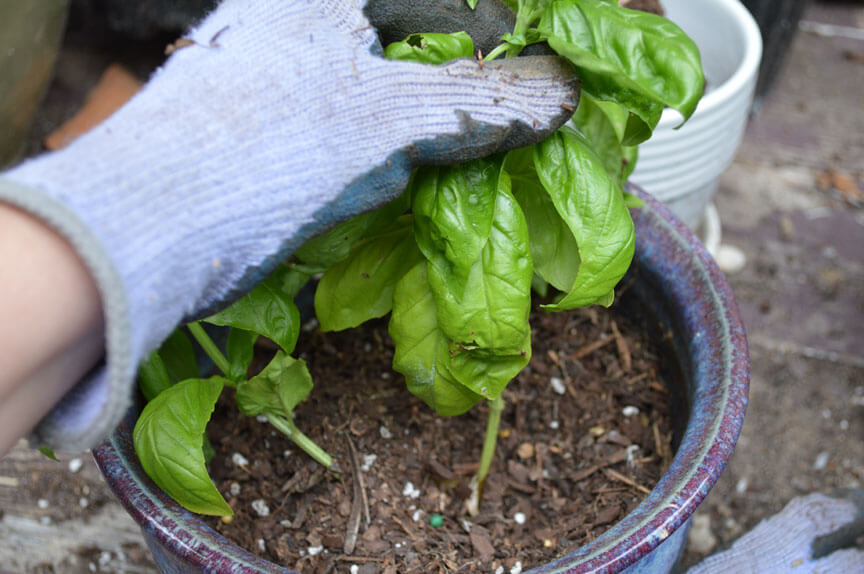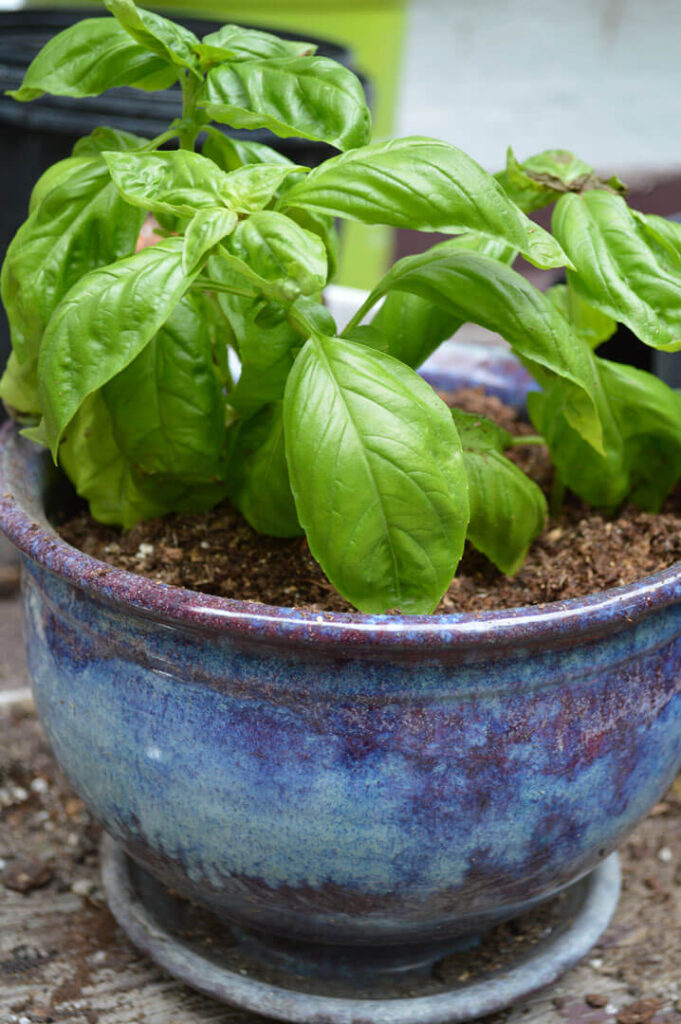
Having fresh herbs to add to your cooking in the winter is a great boon – you just can’t beat that fresh flavor. Now is the time to plan so that you can enjoy the flavor throughout the winter.
Depending on where you live, some of your herbs will survive outdoors even in winter. My herb beds are partially protected by a tree, so they have been known to overwinter just fine, especially in milder winters. But just to be safe, it’s a good idea to start bringing some indoors or putting them in pots.
Basil
Basil is one of the more sensitive herbs. It is the first one that gets frost bitten in my garden. So I have already prepared a pot to bring inside. I will probably add another two pots in another week or so as I really enjoy fresh basil in my cooking.
How To Prepare the Basil – Rooting Cuttings

When it comes to basil, you probably don’t want to dig up an existing plant. This late in the season, the basil plants are usually looking a little rough – leggy, maybe some brown spots, and often going to seed.
The easiest way to get fresh plants is to root some cuttings. Choose a 6” tip of one of your existing plants that does not have seeds or flowers on it. Clip it off and remove the last few leaves from the stem (just enough so that there are no leaves in the water as you root them).
Place about 2-4 cuttings in a glass of water with about 1-2 inches of water in it. Place it in a window where it will only get indirect light and leave it for about a week and a half. Keep an eye on the water, if it begins to get cloudy, change the water.
After about a week and a half, you should see ample roots developing on your basil cuttings.
If you prefer, you can also start some basil from seeds. I find this hard to do indoors unless you have a proper plant light and moisture tray, so I prefer to start with cuttings instead.
Planting the Cuttings
Now you need to prepare a pot. Choose a pot large enough to accommodate the growth of the plants. Basil can grow up to a foot or so tall and will bush out some.
I always line the bottom inch of my indoor planters with some stones. I tend to overwater indoors, so this helps keep the roots from rotting if I do.
Put a few inches of soil in the bottom of the planter, then place your rooted cuttings in the soil, holding them up while you place the soil around them. Don’t add a bunch of soil and then try to push the cuttings into the soil – this will only strip the new roots off. It is better to gently add the soil around the cutting.
Once you have arranged the cuttings the way that you wish in the soil, press down lightly to firm the soil up around the cuttings. Then water the soil.
Place the new plants in a bright sunny window. Basil likes a lot of sun. If you don’t have windows with a lot of sun, you can plan to leave the container outdoors on warm days and bring them in at night.
Oregano
Oregano cuttings can also be rooted. However, it may be easiest just to dig up a small existing section with some roots and transplant it into a container. Oregano does well in a window with moderate sun.
Other Herbs to Consider Bringing Indoors
Other herbs to consider bringing in include parsley (bright sun), sage (bright sun), thyme (bright or part sun), and mint (bright or part sun). Thyme and parsley can easily be dug up and transplanted. Sage and mint you can start from cuttings rather easily. Although you can root fresh rosemary and put it indoors, if you live far enough south, these plants survive the winter quite well.
If you don’t want to bring all of these plants indoors, you can extend the growing season by putting them in containers and protecting them by placing them close to the house (under eaves is best), or by protecting them at night in a garage or shed and putting them out during the day.
Be warned that even with some protection from the elements outdoors, these plants will die if it gets cold enough. Even storage sheds and garages can get pretty cold. I have had a couple of tropical plants die in the wintertime inside my garage. That was a really cold winter!
Winterizing Your Outdoor Herb Beds
To increase the chances of keeping some of your herbs growing outdoors even in winter, add a couple of inches of mulch around the base of the plants. This will help add some insulation during cold weather.
There are also cloths that you can create mini “greenhouses” with to increase the temperature of beds. These cloths need to be draped over a frame or something that keeps them off of the plants.
Here is a good publication that talks about the cold hardiness of common herbs: http://www.ces.ncsu.edu/hil/hil-8112.html



